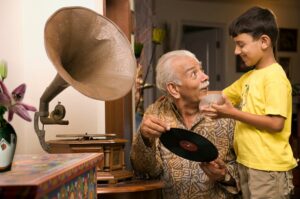Multigenerational homes used to be the norm and are now on the rise again. And not just when there is an acute need to care for grandma or grandpa.
Even before that, bringing your parents into your home can be a win-win situation for all parties. We will tell you what the advantages are for you and your mother and what the prerequisites are for a good life together with grandma.
Table of contents
Mutual Support
When a parent lives together with the next generation in the same house, it is easier to support each other in everyday things. This can be child care and education, household chores or other everyday things like doing the shopping.
You receive support and your children’s grandmother a task that fulfills her everyday life and prevents loneliness – especially when the grandfather has possibly already passed away or crisis situations occur as recently (Corona crisis with Social Distancing).
Even the Federal Ministry for Family Affairs, Senior Citizens, Children and Women has taken up the problem and is currently promoting around 540 multigenerational houses as meeting places for young and old in Germany.
The positive side effect: Because of the controlled proximity, you and your children can exchange ideas with grandma much more often, learn even more about her life and possibly learn a thing or two.
Living Together With Grandma: What To Watch Out For?
In order to make living together work, certain free spaces and places of retreat should be created. A granny apartment would be ideal. But even if such an apartment is not available, there are ways to separate the private areas sufficiently.
After all, one person doesn’t always have to be aware of everything the other is doing. Perhaps an upper floor can be arranged for you, your husband and your children and the first floor for grandma?
Care At Home Means: Giving Something Back
Either the time is already here, or it will come when your mother can no longer support you in the way she did in the beginning. Now it’s time to give something back.
And there’s no better place to do that than in a shared home. On the one hand, you fulfill your mother’s often cherished wish to be able to remain living in a familiar environment in old age. On the other hand, home care saves costs.
- Nursing homes are extremely expensive and the benefits of long-term care insurance are usually not enough to cover the total costs.
- In addition, as a family caregiver, you are supported by the nursing care insurance funds with fixed budgets for preventive care, short-term care, and day and aftercare as relief. This even allows for an occasional vacation if the care needs of your own mother (or mother-in-law) are very high.
- If the need for care is low and you are supported by an outpatient care service, you can often continue to do your job without restrictions.
- If it is not (or no longer) possible to carry out the job, pension and social security contributions are paid by the insurance companies. This means that you are also entitled to unemployment benefits and help with reintegration into working life after the care period.
- For your financial security, your (mother-in-law) can pass on the care allowance to you. The amount depends on the respective care degree and is between 316 and 901 euros / month.
- However, the care allowance can also be used to finance household services such as meals on wheels or a laundry service. If you want to continue working, this would be an enormous relief.
Granny On Board: Accessibility Guaranteed?
In the rarest of cases, homes are designed with the needs of seniors in mind. So to ensure that grandma can manage alone in your future shared four walls, the flooring should be slip-resistant and showers or bathtubs should be step-free.
If your mother is now or later dependent on a wheelchair or rollator, you should also make sure that the door is wide enough. The exact requirements for barrier-free homes are defined in DIN 18040-2.
The situation becomes particularly tricky when stairs have to be negotiated. Even if the grandmother is in principle still well on foot, climbing stairs can cause pain – not to mention the risk of falling, which is significantly increased in old age.
That means: Even if acquisition and installation are connected with certain costs, one should think at this point about a stair lift. The question, which stairlift fits to your living situation, you should clarify best personally with a regional provider.
Subsidies For Barrier-Free And Age-Appropriate Conversions
A possible conversion will not only benefit your grandma but also you if you yourself should be dependent on certain aids one day. The value of the property is also increased by the barrier-free modernization.
The modernization can be financed through the nursing care subsidy for measures to improve the living environment. This is already paid to your grandma from care level 1 and amounts to a one-time payment of 4,000 euros. If grandpa also moves in and also has a care degree, even 8,000 euros would be paid.
Alternatively, the state development bank KfW also supports senior-friendly conversions with a direct grant and a particularly low-interest loan. This is not bound in contrast to the care cash subsidy to a care degree and can be used accordingly also for the purely prophylactic modernization.
All that is required is an informal application to the relevant long-term care insurance company. Whether and if which care degree can be assigned will be clarified by a subsequent expert opinion.









